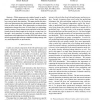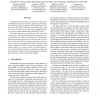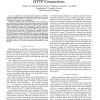718 search results - page 10 / 144 » Energy saving and network performance: a trade-off approach |
ASPDAC
2006
ACM
14 years 1 months ago
2006
ACM
Abstract— While numerous prior studies focused on performance and energy optimizations for caches, their interactions have received much less attention. This paper studies this i...
DATE
2008
IEEE
14 years 2 months ago
2008
IEEE
Fetching instructions from a set-associative cache in an embedded processor can consume a large amount of energy due to the tag checks performed. Recent proposals to address this ...
ICCAD
2001
IEEE
14 years 4 months ago
2001
IEEE
Dynamic voltage scaling (DVS) is a technique that varies the supply voltage and clock frequency based on the computation load to provide desired performance with the minimal amoun...
NOSSDAV
2004
Springer
14 years 1 months ago
2004
Springer
—In mobile devices, the wireless network interface card (WNIC) consumes a significant portion of overall system energy. One way to reduce energy consumed by a WNIC is to transit...
MICRO
2002
IEEE
13 years 7 months ago
2002
IEEE
Power consumption and power density for the Translation Lookaside Buffer (TLB) are important considerations not only in its design, but can have a consequence on cache design as w...



